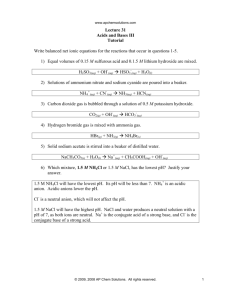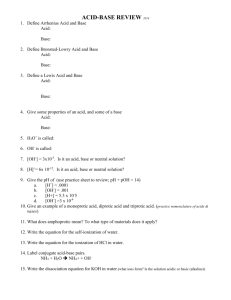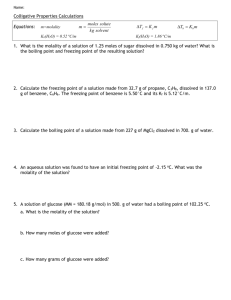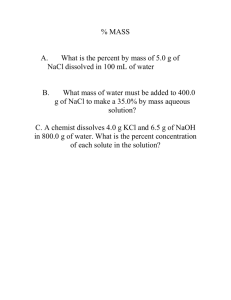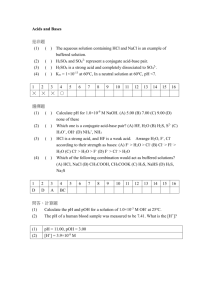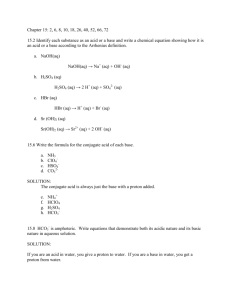FINAL Exam Study Guide
advertisement
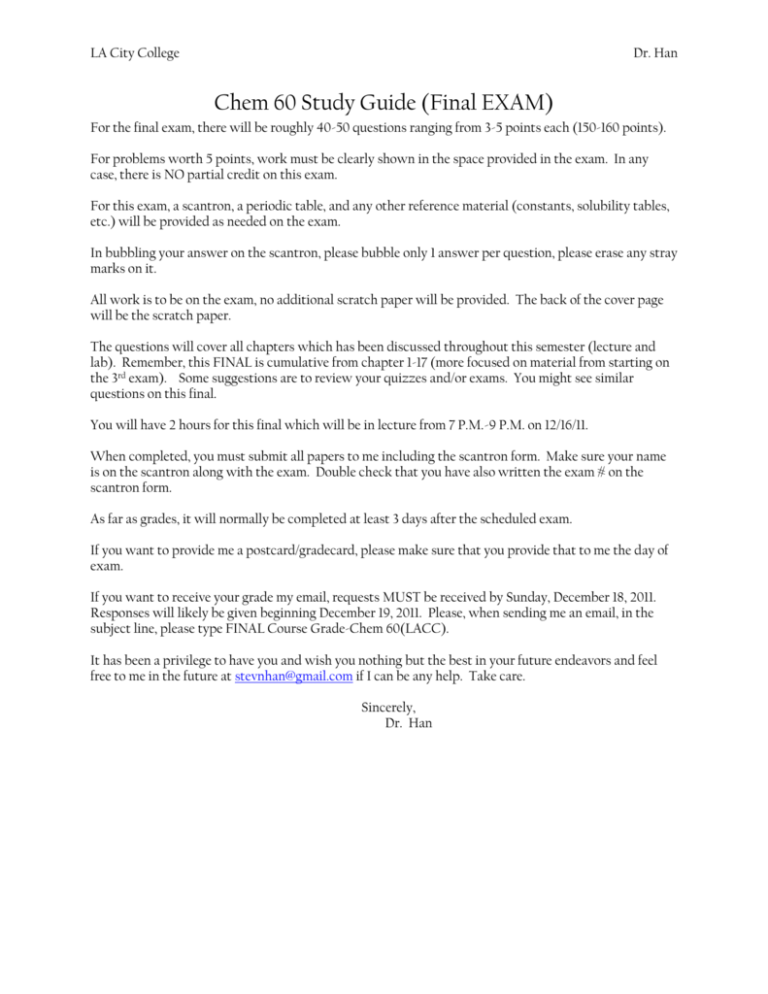
LA City College Dr. Han Chem 60 Study Guide (Final EXAM) For the final exam, there will be roughly 40-50 questions ranging from 3-5 points each (150-160 points). For problems worth 5 points, work must be clearly shown in the space provided in the exam. In any case, there is NO partial credit on this exam. For this exam, a scantron, a periodic table, and any other reference material (constants, solubility tables, etc.) will be provided as needed on the exam. In bubbling your answer on the scantron, please bubble only 1 answer per question, please erase any stray marks on it. All work is to be on the exam, no additional scratch paper will be provided. The back of the cover page will be the scratch paper. The questions will cover all chapters which has been discussed throughout this semester (lecture and lab). Remember, this FINAL is cumulative from chapter 1-17 (more focused on material from starting on the 3rd exam). Some suggestions are to review your quizzes and/or exams. You might see similar questions on this final. You will have 2 hours for this final which will be in lecture from 7 P.M.-9 P.M. on 12/16/11. When completed, you must submit all papers to me including the scantron form. Make sure your name is on the scantron along with the exam. Double check that you have also written the exam # on the scantron form. As far as grades, it will normally be completed at least 3 days after the scheduled exam. If you want to provide me a postcard/gradecard, please make sure that you provide that to me the day of exam. If you want to receive your grade my email, requests MUST be received by Sunday, December 18, 2011. Responses will likely be given beginning December 19, 2011. Please, when sending me an email, in the subject line, please type FINAL Course Grade-Chem 60(LACC). It has been a privilege to have you and wish you nothing but the best in your future endeavors and feel free to me in the future at stevnhan@gmail.com if I can be any help. Take care. Sincerely, Dr. Han LA City College Dr. Han In order to do well on this exam, the student MUST master the following material: Chapter 16: Know what is a solution. Know the components and classifications of a solution. Classification of a mixture (unsaturated, saturated, or supersaturated, diluted or concentrated). Determine if the components in a mixture develops a soluble/insoluble or miscible/immiscible. Know the factors solubility has from (a) IMF-intermolecular force(s), (b) partial pressure, (c) temperature Calculate solution concentration in (a) mass %, (b) molarity (mol/L), (c) molality (m) Perform dilution calculations. Perform solution stoichiometry (w/chemical equations) including titration analysis. Determine the boiling point and/or freezing point of a solution. Determine the molar mass of a solution from either a given molality and/or boiling point or freezing point. Determine the relative aqueous solution’s boiling point and/or freezing point of a solution by the class of electrolyte (strong, weak or nonelectrolyte). Chapter 17: Know and understand the following theories of acids and bases: 1. Arrhenius Theory 2. Brönsted-Lowry Theory 3. Lewis Theory Identify a conjugate acid-base pair by the Brönsted-Lowry theory. Determine the relative strength of acids or bases. Predict the conjugate acid and base with its given acid and base according to the Brönsted-Lowry theory. Perform pH and/or pOH calculations. Perform [H+] and/or [OH-] calculations. Given Kw = 1.0 x 10-14 Plus, you will need to review previous study guides and exams. Also, review your labs because they can be incorporated and asked on the final. Also, look at the assigned problems at OWL and in your textbook. Make sure you understand the concepts relative to the question in each section. Good luck!!! LA City College Dr. Han PRACTICE Problems This is just to see how you would handle the multiple choice and problem solving portion of the exam. Expect no key to be provided. If you’re struggling with any of these questions, please refer back to your textbook and reread the section which best explain the concept(s) of the question. 1. Determine the conjugate conjugate acids for the following species. a. SO42b. HC2O4c. CNd. BO332. Determine the conjugate conjugate bases for the following species. a. HNO2 b. HCO3c. HPO42d. H2O 3. Initially, 0.56g of oxalic acid (H2C2O4) was dissolved in sufficient water in a 250-mL Erlenmeyer flask. It was titrated against an unknown potassium hydroxide solution and determined it required 35.44mL of base solution to neutralize this mixture. Write the balanced, chemical equation and determine the molarity of the potassium hydroxide solution. 4. What mass of PbCl2 is formed when 50.00mL of 0.250M Pb(NO3)2 reacts with excess KCl? Hint: Write the balanced, chemical equation. 5. What volume of 3.0M HNO3 solution is needed to produce 100.0mL of a 0.80M HNO3 solution? 6. A 25.00-mL of KNO3 solution weighs 25.66g. When this solution has evaporated, the dry residue weighs 3.84g. Determine the following: a. Mass percent (mass/mass) b. Mass percent (mass/volume) c. Molarity d. Density e. Molality 7. Determine the boiling and freezing points of a 4.33g of KNO3 sample in 400. g of water. Kf = 1.86 oC/m & Kb= 0.512 oC/m 8. If the [H+] = 0.0051M, determine if this solution is acidic, basic, or neutral. If your explanation, support it with determining the pH, pOH and [OH-] of this solution. 9. If the solubility of X (an unknown substance) is 45g X/100g H2O in water, determine if the following solution compositions will result in (a) unsaturated, (b) saturated or (c) supersaturated solution. Please show work in support of your answer. (a) 45g X/50g H2O (b) 22.5g X/50g H2O (c) 30g X/200g H2O (d) 10g X/25g H2O LA City College Dr. Han This is a list of equations and/or values to be provided in a separate part of this exam. English ↔ English Conversions 1 foot (ft) = 12 inches (in) 1 yard (yd) = 3 feet (ft) 1 mile (mi) = 5280 feet (ft) 1 quart (qt) = 4 cups 1 quart (qt) = 2 pints (pt) 1 gallon (gal) = 4 quarts (qt) 1 pound (lb) = 16 ounces (oz) Metric ↔ English Conversions 2.54 centimeter (cm) = 1 inch (in) 1 meter (m) = 39.37 inch (in) 1 kilometer (km) = 0.6214 miles (mi) 1.61 kilometer (km) = 1 mile (mi) 1 Liter (L) = 1.057 quart (qt) 3.785 Liter = 1 gallon 1 kilogram (kg) = 2.205 pound (lb) 453 grams = 1 pound (lb) Other useful information STP = Standard Temperature and Pressure °F = 1.8°C + 32 °C = (°F – 32) 1.8 °C = K – 273.15 K = °C + 273.15 V = r2h (Cylinder) V = (1/3) r2h (Cone) 3 V = (4/3) r (Sphere) A= r2 (Circle) density = m/V P1 V1 = P2 V2 T1 T2 PV = nRT where R = 0.0821 L · atm/mol · K or 62.4 L · Torr / mol · K E=h E=hc/ Tb = Kb m Tf = Kf m c =3.00 x 108 m/s pH = -log [H+] pOH = -log [OH-] Kw = 1.0 x 10-14 = [H+][OH-] pH + pOH = 14.00 There will be also a periodic table, activity series, electronegativity table, solubility table, density tables, and any applicable freezing-point and boiling point constants (for molality).
